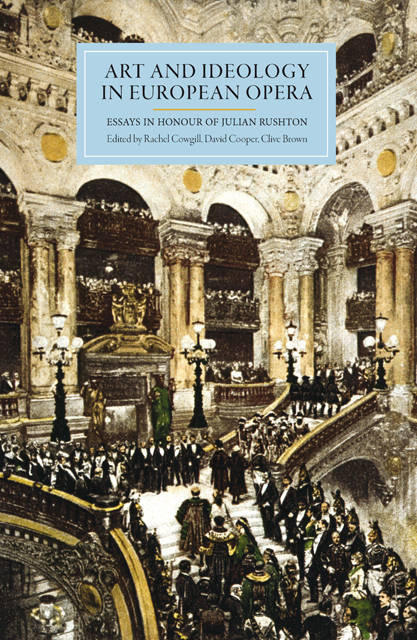Book contents
- Frontmatter
- Contents
- List of Figures
- List of Music Examples
- List of Tables
- Notes on Editors and Contributors
- Acknowledgements
- Introduction
- I Nationalism, Cosmopolitanism and National Opera
- II Opera, Class and the Politics of Enlightenment
- III Opera and Otherness
- Julian Rushton: A Family Memoir
- 7 The Works of Julian Rushton
- Index
- Tabula Gratulatoria
13 - Beyond Orientalism: The International Rise of Japan and the Revisions to Madama Butterfly
Published online by Cambridge University Press: 28 February 2023
- Frontmatter
- Contents
- List of Figures
- List of Music Examples
- List of Tables
- Notes on Editors and Contributors
- Acknowledgements
- Introduction
- I Nationalism, Cosmopolitanism and National Opera
- II Opera, Class and the Politics of Enlightenment
- III Opera and Otherness
- Julian Rushton: A Family Memoir
- 7 The Works of Julian Rushton
- Index
- Tabula Gratulatoria
Summary
Madama Butterfly is perhaps the primary archetype for what Ralph Locke has termed ‘orientalist opera’; yet it came into existence at a time when a number of political events involving its subject matter – Japan – contributed to a re-evaluation of the worldview that underlies this category. Following the La Scala debacle of 17 February 1904, which roughly coincided with the opening of the Russo-Japanese War, Puccini embarked on almost three years of revisions (from early 1904 to December 1906), a process requiring at least seven different printings of the vocal score. This period was one of growing international anxiety as Japan literally fought its way through to challenge not only many a racial stereotype and preconception, but also the great-power world order that was largely constructed upon them. Countries responded by reinforcing a latent image of Japan as an ambiguous entity that resists being confined by the binary intellectual constructs of orientalism. This ‘ambiguous Japan’, which appears to be both civilized and barbarian, progressive and traditionalist, modern but exotic, neither completely ‘us’ nor entirely ‘them’, ultimately seems to threaten Western supremacy by challenging its conceptions of civilization and claims to moral superiority embedded in conventional orientalist narrative and thought. My purpose here is to show how Puccini's revisions to Madama Butterfly took account of new perceptions of Japan that resulted from this particularly turbulent period in the international arena.
Japan in the World by the Turn of the Century
The initial absorption of Japan into the ‘corporate institution for dealing with the Orient’ is not being disputed. Japanese participation in several World Fairs and exhibitions in Europe and America gave rise to great curiosity. In Europe, the rise of japonisme and the general influence of things Japanese in the visual and decorative arts is a well-documented phenomenon, visible in the output of Manet, Degas, Monet, van Gogh, Gauguin and several other artists. Among the widely circulated novels with Japanese subject matter published during the last two decades of the nineteenth century we find two sources close to Puccini's and Illica's Madama Butterfly: Pierre Loti's Madame Chrysantheme (1888) and John Luther Long's Madam Butterfly (1898).
- Type
- Chapter
- Information
- Art and Ideology in European OperaEssays in Honour of Julian Rushton, pp. 281 - 302Publisher: Boydell & BrewerPrint publication year: 2010

